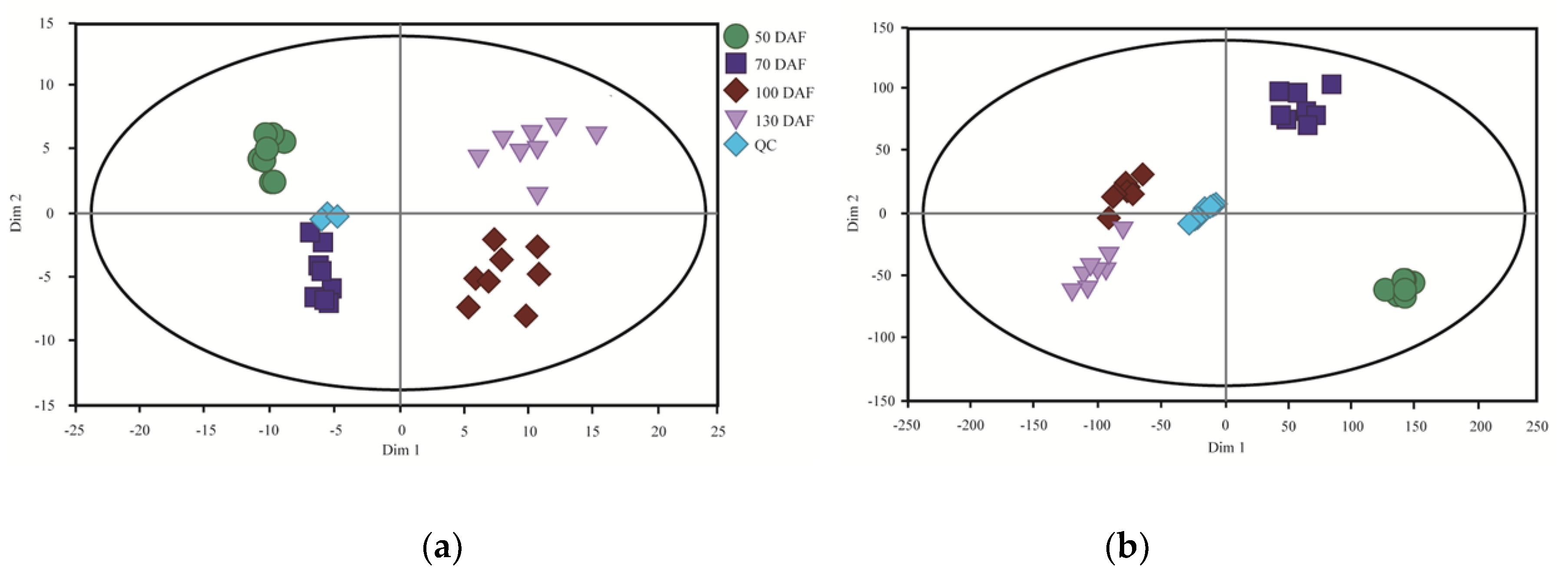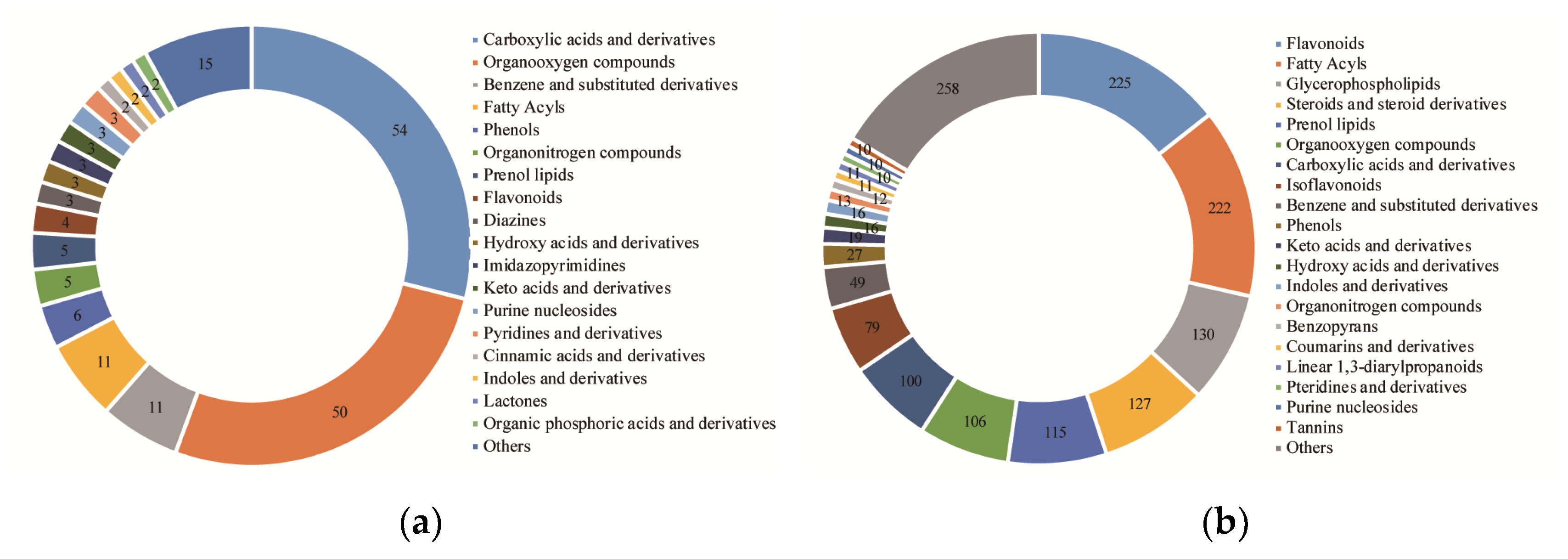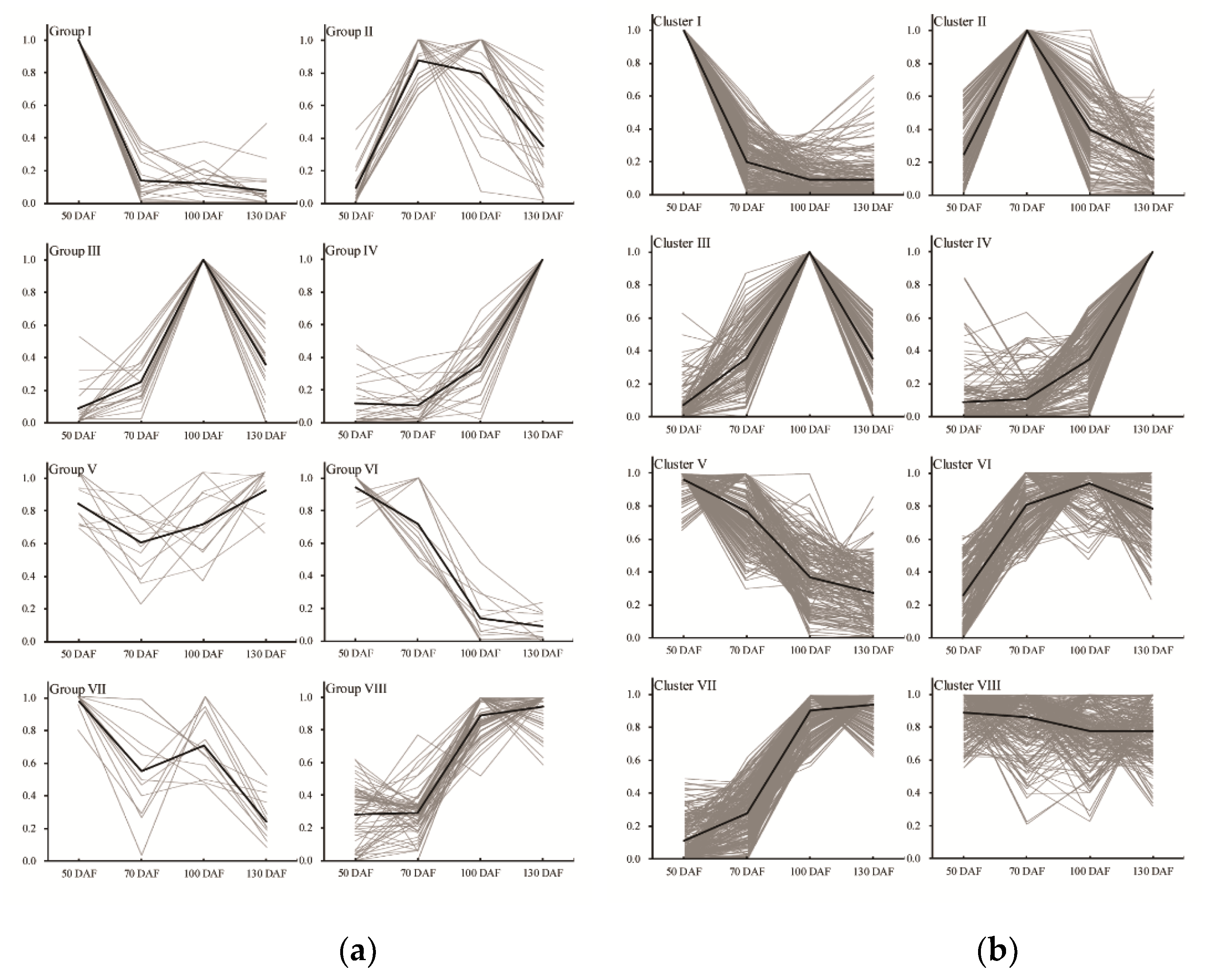Metabolite Profiling and Classification of Developing Styrax tonkinensis Kernels
Abstract
1. Introduction
2. Results
2.1. Quality Control Result
2.2. Metabolite Identification
2.3. Differential Metabolites Analysis and Pathway Enrichment
3. Discussion
4. Materials and Methods
4.1. Plant Materials
4.2. GC-MS Analysis
4.2.1. GC-MS Sample Preparation
- 60 mg samples were transferred into a 1.5 mL Eppendorf tube with two small steel balls.
- 40 μL boc-2-chloro-L-phenylalanine in 0.3 mg/mL methanol solution as internal standard and 360 μL pre-cooling methanol were added respectively.
- The samples were placed at −80 °C for 2 min and then ground at 60 Hz for 2 min, before ultrasonic extraction at room temperature for 30 min.
- 200 μL chloroform and 400 μL water were added.
- The samples were extracted at room temperature for 30 min and then centrifuged at 12,000 rpm at 4 °C for 10 min.
- 500 μL supernatant was transferred into GC vials.
- The samples were dried with a freeze concentration centrifugal dryer, and then 80 μL methoxamine-hydrochloride in pyridine (15 mg/mL) was added (with vortex oscillation for 2 min).This was placed at 37 °C for 90 min for an oximation reaction.
- 80 μL bis (trimethylsilyl) trifluoroacetamide (BSTFA) containing 1% trimethylchlorosilane (TMCS) and 20 μL n-hexane were added, and vortex oscillation for 2 min followed.
- The samples were placed at 70 °C for 60 min and then at room temperature for 30 min for GM-LC analysis.
- Quality control samples (QCs) were prepared by mixing all samples, which were analyzed using the same method as with the analytic samples. The QCs were injected at regular intervals to assess the repeatability of the whole analytical process.
4.2.2. GC Conditions and MS Method
4.2.3. GC-MS Data Collection
4.3. LC-MS Analysis
4.3.1. LC-MS Sample Preparation
- 80 mg samples were transferred into a 1.5 mL Eppendorf tube with two small steel balls.
- 20 μL boc-2-chloro-L-phenylalanine in methanol and water (1/1, v/v) as internal standard and 1 mL pre-cooling methanol solution (7/1, v/v) were added respectively.
- The samples were placed at −80 °C for 2 min and then ground at 60 Hz for 2 min, before ultrasonic extraction at room temperature for 30 min.
- The samples were placed at 4 °C for 20 min and then centrifuged at 14,000 rpm at 4 °C for 10 min.
- 500 μL supernatants were filtered through 0.22 μm microfilters and then transferred into LC vials.
- QCs were prepared by mixing all of the all samples in the same way as with the GC-MS analysis.
4.3.2. LC Conditions and MS Method
4.3.3. LC-MS Data Collection
4.4. Data Analysis and Bioinformatics Analysis
5. Conclusions
Supplementary Materials
Author Contributions
Funding
Acknowledgments
Conflicts of Interest
References
- Pinyopusarerk, K. Styrax tonkinensis: Taxonomy, ecology, silviculture and uses. In ACIAR Technical Reports No.31, 2nd ed.; Julie, H., Ed.; CPN Publication: Canberra, Australia, 1994; Volume 20, pp. 1–20. [Google Scholar]
- Xu, L.P.; Yu, F.Y. Corolla structure and fragrance components in Styrax tonkinensis. Trees Struct. Funct. 2015, 29, 1127–1134. [Google Scholar] [CrossRef]
- Zhang, Z.H.; Wang, X.J.; Luo, Y.; Yu, F.Y. Carbon competition between fatty acids and starch during benzoin seeds maturation slows oil accumulation speed. Trees Struct. Funct. 2017, 31, 1025–1039. [Google Scholar] [CrossRef]
- Courel, B.; Adam, P.; Schaeffer, P. The potential of triterpenoids as chemotaxonomic tools to identify and differentiate genuine, adulterated and archaeological balsams. Microchem. J. 2019, 147, 411–421. [Google Scholar] [CrossRef]
- Sasaki, C.; Negoro, H.; Asada, C.; Nakamura, Y. Microwave-assisted glucose production from bode (Styrax tonkinensis) woody biomass for bioethanol production. J. Mater. Cycles Waste Manag. 2019, 21, 201–204. [Google Scholar] [CrossRef]
- Wu, Q.K.; Fei, X.R.; Gao, Y.; Chen, C.; Cao, Y.Y.; Yu, F.Y. Comparative analysis of fuel properties of eight biodiesel plants species of Styrax spp. China Oils Fats 2019, 44, 27–30. [Google Scholar]
- Zhang, Z.H.; Luo, Y.; Wang, X.J.; Yu, F.Y. Quantitative spatiotemporal oil body ultrastructure helps to verify the distinct lipid deposition patterns in Benzoin endosperm and embryo cells. Forests 2018, 9, 265. [Google Scholar] [CrossRef]
- Zhang, C.X.; Tanabe, K.; Tamura, F.; Matsumoto, K.; Yoshida, A. 13C-photosynthate accumulation in Japanese pear fruit during the period of rapid fruit growth is limited by the sink strength of fruit rather than by the transport capacity of the pedicel. J. Exp. Bot. 2005, 56, 2713–2719. [Google Scholar] [CrossRef]
- Conde, C.; Delrot, S.; Geros, H. Physiological, biochemical and molecular changes occurring during olive development and ripening. J. Plant Physiol. 2008, 165, 1545–1562. [Google Scholar] [CrossRef]
- Ruan, Y.L.; Patrick, J.W.; Bouzayen, M.; Osorio, S.; Fernie, A.R. Molecular regulation of seed and fruit set. Trends Plant Sci. 2012, 17, 656–665. [Google Scholar] [CrossRef]
- Hajduch, M.; Casteel, J.E.; Hurrelmeyer, K.E.; Song, Z.; Agrawal, G.K.; Thelen, J.J. Proteomic analysis of seed filling in Brassica napus. developmental characterization of metabolic isozymes using high-resolution two-dimensional gel electrophoresis. Plant Physiol. 2006, 141, 32–46. [Google Scholar] [CrossRef]
- Matheus, M.T.; Lopes, J.C.; Correa, N.B. Physiological maturation of Erythrina variegata L. seeds. Cienc. Florest. 2011, 21, 619–627. [Google Scholar] [CrossRef]
- Ogura, T.; Bamba, T.; Fukusaki, E. Development of a practical metabolite identification technique for non-targeted metabolomics. J. Chromatogr. A 2013, 1301, 73–79. [Google Scholar] [CrossRef]
- Lisec, J.; Schauer, N.; Kopka, J.; Willmitzer, L.; Fernie, A.R. Gas chromatography mass spectrometry-based metabolite profiling in plants. Nat. Protoc. 2006, 1, 387–396. [Google Scholar] [CrossRef]
- Allwood, J.W.; Goodacre, R. An introduction to liquid chromatography-mass spectrometry instrumentation applied in plant metabolomic analyses. Phytochem. Anal. 2010, 21, 33–47. [Google Scholar] [CrossRef]
- Marques, F.G.; Neto, J.R.D.; da Cunha, L.C.; de Paula, J.R.L.; Bara, M.T.F. Identification of terpenes and phytosterols in Dipetryx alata (baru) oil seeds obtained through pressing. Rev. Bras. Farmacogn. Braz. J. 2015, 25, 522–525. [Google Scholar] [CrossRef]
- Tsogtbaatar, E.; Cocuron, J.C.; Sonera, M.C.; Alonso, A.P. Metabolite fingerprinting of pennycress (Thlaspi arvense L.) embryos to assess active pathways during oil synthesis. J. Exp. Bot. 2015, 66, 4267–4277. [Google Scholar] [CrossRef]
- Theodoridis, G.A.; Gika, H.G.; Want, E.J.; Wilson, I.D. Liquid chromatography-mass spectrometry based global metabolite profiling: A review. Anal. Chim. Acta 2012, 711, 7–16. [Google Scholar] [CrossRef]
- Sangster, T.; Major, H.; Plumb, R.; Wilson, A.J.; Wilson, I.D. A pragmatic and readily implemented quality control strategy for HPLC-MS and GC-MS-based metabonomic analysis. Analyst 2006, 131, 1075–1078. [Google Scholar] [CrossRef]
- Gerhardt, N.; Schwolow, S.; Rohn, S.; Perez-Cacho, P.R.; Galan-Soldevilla, H.; Arce, L.; Weller, P. Quality assessment of olive oils based on temperature-ramped HS-GC-IMS and sensory evaluation: Comparison of different processing approaches by LDA, kNN, and SVM. Food Chem. 2019, 278, 720–728. [Google Scholar] [CrossRef]
- Wu, Q.K.; Zhang, Z.H.; Peng, H.; Wu, Y.L.; Yu, F.Y. The nutrient distribution in the continuum of the pericarp, seed coat, and kernel during Styrax tonkinensis fruit development. PeerJ 2019, 7, e7996. [Google Scholar] [CrossRef]
- Alonso, A.P.; Val, D.L.; Shachar-Hill, Y. Central metabolic fluxes in the endosperm of developing maize seeds and their implications for metabolic engineering. Metab. Eng. 2011, 13, 96–107. [Google Scholar] [CrossRef] [PubMed]
- Liu, H.; Li, H.F.; Gu, J.Z.; Deng, L.; Ren, L.; Hong, Y.B.; Lu, Q.; Chen, X.P.; Liang, X.Q. Identification of the candidate proteins related to oleic acid accumulation during peanut (Arachis hypogaea L.) seed development through comparative proteome analysis. Int. J. Mol. Sci. 2018, 19, 1235. [Google Scholar] [CrossRef] [PubMed]
- Wang, L.B.; Yu, H.Y.; He, X.H.; Liu, R.Y. Influence of fatty acid composition of woody biodiesel plants on the fuel properties. J. Fuel Chem. Technol. 2012, 40, 397–404. [Google Scholar] [CrossRef]
- Xu, C.C.; Shanklin, J. Triacylglycerol metabolism, function, and accumulation in plant vegetative tissues. Annu. Rev. Plant Biol. 2016, 67, 179–206. [Google Scholar] [CrossRef] [PubMed]
- Rawsthorne, S. Carbon flux and fatty acid synthesis in plants. Prog. Lipid Res. 2002, 41, 182–196. [Google Scholar] [CrossRef]
- Burger, P.; Casale, A.; Kerdudo, A.; Michel, T.; Laville, R.; Chagnaud, F.; Fernandez, X. New insights in the chemical composition of benzoin balsams. Food Chem. 2016, 210, 613–622. [Google Scholar] [CrossRef]
- Moore, B.D.; Andrew, R.L.; Kulheim, C.; Foley, W.J. Explaining intraspecific diversity in plant secondary metabolites in an ecological context. New Phytol. 2014, 201, 733–750. [Google Scholar] [CrossRef]
- Loke, K.K.; Rahnamaie-Tajadod, R.; Yeoh, C.C.; Goh, H.H.; Mohamed-Hussein, Z.A.; Zainal, Z.; Ismail, I.; Noor, N.M. Transcriptome analysis of Polygonum minus reveals candidate genes involved in important secondary metabolic pathways of phenylpropanoids and flavonoids. PeerJ 2017, 5, e2938. [Google Scholar] [CrossRef]
- Nonato, C.D.A.; Leite, D.O.D.; Pereira, R.C.; Boligon, A.A.; Ribeiro, J.; Rodrigues, F.F.G.; da Costa, J.G.M. Chemical analysis and evaluation of antioxidant and antimicrobial activities of fruit fractions of Mauritia flexuosa L. f. (Arecaceae). PeerJ 2018, 6, e5991. [Google Scholar] [CrossRef]
- Agrawal, A.D. Pharmacological activities of flavonoids: A review. Int. J. Pharm. Sci. Nanotechnol. 2011, 4, 1394–1398. [Google Scholar]
- Koirala, N.; Thuan, N.H.; Ghimire, G.P.; Thang, D.V.; Sohng, J.K. Methylation of flavonoids: Chemical structures, bioactivities, progress and perspectives for biotechnological production. Enzyme Microb. Technol. 2016, 86, 103–116. [Google Scholar] [CrossRef] [PubMed]
- Li, J.; Hossain, M.S.; Ma, H.C.; Yang, Q.H.; Gong, X.W.; Yang, P.; Feng, B.L. Comparative metabolomics reveals differences in flavonoid metabolites among different coloured buckwheat flowers. J. Food Compos. Anal. 2020, 85, 103335. [Google Scholar] [CrossRef]
- Havsteen, B.H. The biochemistry and medical significance of the flavonoids. Pharmacol. Ther. 2002, 96, 67–202. [Google Scholar] [CrossRef]
- Feng, L.; Zhai, Y.Y.; Xu, J.; Yao, W.F.; Cao, Y.D.; Cheng, F.F.; Bao, B.H.; Zhang, L. A review on traditional uses, phytochemistry and pharmacology of Eclipta prostrata L. J. Ethnopharmacol. 2019, 245, 1–14. [Google Scholar] [CrossRef] [PubMed]
- Patti, G.J.; Yanes, O.; Siuzdak, G. Metabolomics: The apogee of the omics trilogy. Nat. Rev. Mol. Cell Biol. 2012, 13, 263–269. [Google Scholar] [CrossRef] [PubMed]
- Li, X.R.; Pei, G.S.; Liu, L.S.; Chen, L.; Zhang, W.W. Metabolomic analysis and lipid accumulation in a glucose tolerant Crypthecodinium cohnii strain obtained by adaptive laboratory evolution. Bioresour. Technol. 2017, 235, 87–95. [Google Scholar] [CrossRef] [PubMed]
- Simcox, P.D.; Dennis, D.T. Isoenzymes of the glycolytic and pentose phosphate pathways in proplastids from the developing endosperm of Ricinis communis L. Plant Physiol. 1978, 61, 87–877. [Google Scholar] [CrossRef]
- Routaboul, J.M.; Kerhoas, L.; Debeaujon, I.; Pourcel, L.; Caboche, M.; Einhorn, J.; Lepiniec, L. Flavonoid diversity and biosynthesis in seed of Arabidopsis thaliana. Planta 2006, 224, 86–107. [Google Scholar] [CrossRef]
- Meng, X.X.; Mujahid, H.; Zhang, Y.D.; Peng, X.J.; Redona, E.D.; Wang, C.L.; Peng, Z.H. Comprehensive analysis of the lysine succinylome and protein co-modifications in developing rice seeds. Mol. Cell. Proteom. 2019, 18, 2359–2372. [Google Scholar] [CrossRef]
- Mokhetho, K.C.; Sandasi, M.; Ahmad, A.; Kamatou, G.P.; Viljoen, A.M. Identification of potential anti-quorum sensing compounds in essential oils: A gas chromatography-based metabolomics approach. J. Essent. Oil Res. 2018, 30, 399–408. [Google Scholar] [CrossRef]
- Tian, L.; Perot, S.J.; Stevenson, D.; Jacobson, T.; Lanahan, A.A.; Amador-Noguez, D.; Olson, D.G.; Lynd, L.R. Metabolome analysis reveals a role for glyceraldehyde 3-phosphate dehydrogenase in the inhibition of C. thermocellum by ethanol. Biotechnol. Biofuels 2017, 10, 276. [Google Scholar] [CrossRef] [PubMed]
- Ogata, H.; Goto, S.; Sato, K.; Fujibuchi, W.; Bono, H.; Kanehisa, M. KEGG: Kyoto encyclopedia of genes and genomes. Nucleic Acids Res. 1999, 27, 29–34. [Google Scholar] [CrossRef] [PubMed]




© 2020 by the authors. Licensee MDPI, Basel, Switzerland. This article is an open access article distributed under the terms and conditions of the Creative Commons Attribution (CC BY) license (http://creativecommons.org/licenses/by/4.0/).
Share and Cite
Wu, Q.; Zhao, X.; Chen, C.; Zhang, Z.; Yu, F. Metabolite Profiling and Classification of Developing Styrax tonkinensis Kernels. Metabolites 2020, 10, 21. https://doi.org/10.3390/metabo10010021
Wu Q, Zhao X, Chen C, Zhang Z, Yu F. Metabolite Profiling and Classification of Developing Styrax tonkinensis Kernels. Metabolites. 2020; 10(1):21. https://doi.org/10.3390/metabo10010021
Chicago/Turabian StyleWu, Qikui, Xue Zhao, Chen Chen, Zihan Zhang, and Fangyuan Yu. 2020. "Metabolite Profiling and Classification of Developing Styrax tonkinensis Kernels" Metabolites 10, no. 1: 21. https://doi.org/10.3390/metabo10010021
APA StyleWu, Q., Zhao, X., Chen, C., Zhang, Z., & Yu, F. (2020). Metabolite Profiling and Classification of Developing Styrax tonkinensis Kernels. Metabolites, 10(1), 21. https://doi.org/10.3390/metabo10010021




